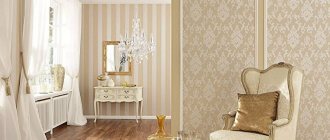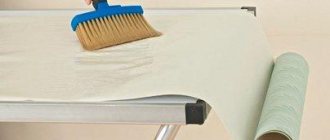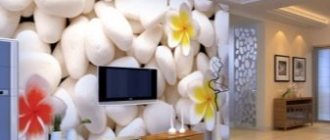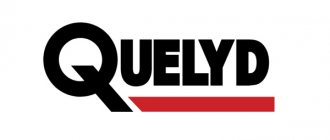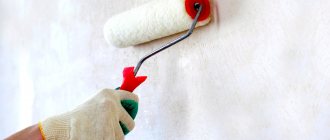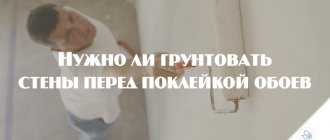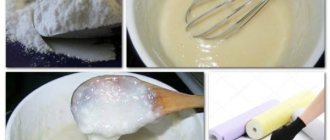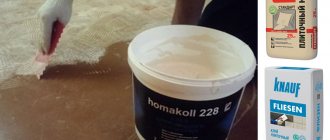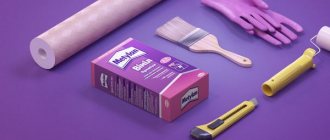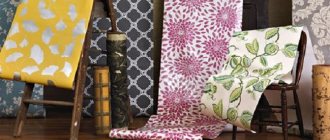How to dilute glue for non-woven wallpaper? In principle, this is a very simple matter. But it also has its tricks and secrets. For example, a person who has made repairs in his home many times has 100% diluted the glue incorrectly. Because adherence to technology ensures that you don’t have to redo the renovation several times in a short period of time or wake up to the sound of wallpaper falling off.
And a beginner, even more so, will have to first study all the recommendations and tips so as not to mess things up. Otherwise, more than one bucket of solution will go to waste before the non-woven wallpaper is firmly glued to the wall.
How to make vinyl wallpaper glue yourself?
Flour-based glue
- sift the flour through a fine sieve;
- thoroughly dissolve the flour in a small amount of cold water;
- 1 liter of water must be boiled;
- pour boiling water in a thin stream into the flour solution; put the mixture on low heat and bring to a boil with constant stirring;
Interesting materials:
How to set up the keyboard on your phone? How to set up the microphone on a Huawei phone? How to set a reminder on your phone? How to adjust spelling on your phone? How to set up call forwarding from a landline phone to a Rostelecom cell phone? How to set up a network on a ZTE Blade phone? How to set a timer on your phone? How to set up Twitch on your phone? How to protect yourself from losing your phone? How to update the keyboard on your phone?
General rules
Finishing specialists recommend purchasing glue and non-woven wallpaper of the same brand. The manufacturer accurately selects the necessary components in the best variation. If the store does not have the same brand, then purchase glue from the most famous companies. Then you definitely won’t have any unpleasant surprises in the form of too liquid a solution or, conversely, a cement mass with lumps.
If you wish, you can consult with the seller. As a rule, they always give a comprehensive answer on all types of non-woven wallpaper and adhesives for them. Only when the seller recommends buying universal glue can you safely judge his incompetence. Because this type of glue can only hold thin paper wallpaper. And even then, on a carefully prepared wall.
We recommend purchasing glue for non-woven wallpaper immediately with a reserve. Firstly, for preliminary priming of walls. This makes joining seams much easier. Secondly, diluted glue can be safely stored for a whole week at room temperature, and dry glue can be stored until the expiration date. Therefore, let it be. Thirdly, if dilution fails, you won’t have to go shopping to find glue of the same brand. Or there won’t be enough liter mug to finish gluing the last piece of non-woven wallpaper - you’ll also have to run out and buy it.
Advice. All tools and containers must be absolutely clean, without a trace of other solutions. There is nothing worse when, trying to smooth out the wallpaper on the wall, people tore off thin strips of non-woven material with pieces of dried cement mortar or grains of sand that got into the adhesive mixture.
Specifications
Exclusive non-woven adhesive from Imperial Starch, which has been creating adhesive solutions for various purposes for many years, is distinguished by its strength properties. The instructions indicate the following technical characteristics of the glue:
- Can be applied by roller or brush;
- Available in a box containing a package with the product;
- Shelf life is 5 years;
- The average consumption is 40 grams per square meter of surface;
- The glue should be stored in the package at temperatures from +10 to +20 degrees in a dry place.
Exclusive glue is distinguished by its strength properties.
There are several advantages of Exclusive wallpaper glue:
- Ease of use;
- High setting rate;
- Excellent slip performance; correcting the position of the blades is very simple;
- The ability to store the finished glue for a long time, up to 7 days, while ensuring that the container is tightly closed;
- The presence of antiseptic elements in the composition;
- Safety for human health, the composition is environmentally friendly.
Excellent sliding performance; correcting the position of the blades is very simple.
Work order
You can’t just dump the entire pack of dry mixture into water and get a decent result. You need to know how to dilute glue for non-woven wallpaper. Now let's learn.
Required tools and materials:
- Container with a volume of at least 10 liters. Bucket, basin, large bowl.
- Glue of the selected brand.
- Warm water. Not cold and not hot!
- Stick, whisk, whisk, drill, construction or household mixer.
- Measuring cup or spoon
- The desire to quickly get rid of the nerve-wracking task of repairs.
Let's get started. Pour a precisely measured amount of clean warm water into the container. We prepare the required amount of dry mixture in advance. Always use a measuring cup or spoon. An error of even 50 g by eye can be fatal.
Now quickly stir the water until a funnel forms. We begin to sprinkle dry glue in a thin, even stream. All this time we continuously stir the water in one direction. We recommend using a stick or paddle to start. The mixer will not make the desired funnel; it will simply immediately whip up the glue on the surface, not allowing it to come into proper contact with the water. And the dry mixture will also begin to fly out of the container.
After pouring out the entire measured dose of glue, stir for another minute. Now you can take a drill with an attachment or a construction mixer. A power tool will do a much better job of breaking up all the small lumps that might have formed.
It is perfectly acceptable to use a regular kitchen mixer with whisks, but there is a trick. To prevent splashes of diluted glue from flying in all directions, leave only one nozzle. Two will give foam and spread your finished glue along the walls and over you. And one will simply mix the solution efficiently.
Now you can wait 14-16 minutes until the finished mixture is saturated with water and swells. During this time, the glue for non-woven wallpaper will become a little denser. Check the consistency. It should resemble thick jelly or thick sour cream. If the finished glue is too thick for your liking, then add another 200 ml of clean water. Then mix thoroughly again.
All manipulations for additional dilution are recommended to be performed in the first half hour after mixing. Then the glue will swell. Instead of a ready-made plastic mixture, you will get water with floating clots. Even if you manage to stir such a brew until smooth, no one guarantees the preservation of all the properties declared by the manufacturer. This will already be a violation of the technological process. Therefore, try to get everything done in the first 30 minutes, no more.
Now you can safely start gluing wallpaper. You mixed the glue yourself.
Advice. Non-woven wallpaper does not need glue. It is applied only to the wall, and then a dry cut of the required length is glued.
Some useful tips
- Always read the manufacturer's instructions on the packaging before starting work. Because Russian people usually grab the instructions when they understand that something has gone wrong.
- The exact proportions of the amount of water and glue are deliberately not given here. Because they vary significantly for each company. The only recommendation: always take 0.5 liters less water than what is written in the instructions. It is better to add this amount later if the mixture seems thick to you. Because liquid glue can no longer thicken.
- Do not pour the entire dry mixture into the water in one fell swoop. You will get a dense lump, which will be difficult to stir later. And lumps of finished glue can leave unsightly swellings or small bubbles under non-woven wallpaper.
- By the way, non-woven wallpaper sticks better with thick glue. If used correctly, it will then be difficult to find the joints of the sheets yourself.
- If your joints peel off after drying, we recommend purchasing a special pencil for gluing. It provides a thin but strong adhesive layer. And the thickness of the rod makes it convenient to use at joints. In addition, it does not leave streaks or other marks on the dark picture.
- Some sources recommend adding PVA glue to the finished mixture. They say the wallpaper lasts better this way. We really don't recommend doing this. If you follow all the instructions, the wallpaper will hold up well even without PVA. And during the next renovation, there is a high probability of removing the old wallpaper along with pieces of the walls. After all, PVA has very good adhesion.
- Do not cook glue for non-woven wallpaper the old fashioned way, from starch or flour. This is the last century. Such a mess can easily hold ordinary paper wallpaper on the wall. But non-woven ones will remarkably fall off in whole layers within a week. At the same time, you will no longer be able to reattach them to normal industrial glue. Because the paste disrupts the structure of the non-woven fabric. Don't create problems and headaches for yourself. If your budget includes the amount for good wallpaper, then allocate funds for the right glue. It's not that expensive.
How to dilute glue for non-woven wallpaper? Now you definitely know all the technology. And in any situation you can easily and effortlessly apply the required amount of glue to the required consistency. Happy renovation!
https://howtogetrid.ru/kak-razvesti-klej-dlya-flizelinovyx-oboev/
General description and purpose
CMC glue is produced at chemical plants based on cellulose. If you decipher the abbreviation CMC itself, you get the word - carboxymethylcellulose. In addition to the cellulose processing product, the glue contains anti-caking agents and antifungal agents. All components, although of synthetic origin, do not cause harm to health.
CMC is designed for gluing various types of wallpaper to any surface (concrete, plaster, wood). Several types of glue are produced. They differ in the percentage of carboxymethylcellulose sodium salt (the higher this figure, the greater the adhesive ability of the glue).
CMC is added to cement mixtures and gypsum putties to increase their strength. This product is used in various industrial sectors. The glue has the appearance of a loose powdery snow-white powder. If the CMC is yellow, it means the product has long expired.
CMC is the most popular repair product due to its ease of use and low cost. Before use, the glue is diluted with water in the dosage specified in the instructions. Then it is left to swell (depending on the type of CMC) for 15 minutes or 2-3 hours. The finished mixture resembles a colorless, gelatinous, viscous mass. The solution never forms clots or lumps, has no odor, and does not leave yellowish stains on the wallpaper. The viability of a 4 percent mixture is as much as seven days.
Preparatory activities
The sequence of preparing the rough base for wallpapering:
- The old facing material is removed.
Preparation
- The rough surface of the wall is inspected. Existing defects are eliminated: cracks, cracks, chips and holes. The base is plastered or puttyed depending on the existing irregularities. Full plastering of the walls may be required. If necessary, areas are rubbed with emery cloth to achieve a smooth surface.
- The surface is covered with a primer composition. It is recommended to apply the primer in two layers. Moreover, the second one is done after the previous layer has completely dried. The strength of the base increases. The adhesion of glue to decorative fabrics increases. There is a significant reduction in fixative consumption.
Range
Currently, the following types of Exclusive glue are present on the windows of our stores:
- Exclusive For Paper - from the name it is clear that this glue is for paper wallpaper;
- Exclusive Vinyl - wallpaper adhesive for all types of vinyl wallpaper;
- Exclusive Non-Woven - wallpaper adhesive with non-woven backing; the peculiarity of this adhesive composition is that it is specially designed for application to the wall;
- Exclusive Platinum - used for gluing glass wallpaper.
English manufacturers took care of the builders and prepared glue for each type of wallpaper. Therefore, choose exactly the glue that is suitable for your type of wallpaper, because they differ in composition, this will be especially noticeable when you prepare the glue.
Assortment of English glue in old packs
The non-woven composition is suitable for wallpaper with an appropriate backing, and paper adhesive is applicable exclusively for all types of paper wallpaper.
Review of popular manufacturers
The choice of the best wallpaper glue for non-woven wallpaper always depends on the technical characteristics of the composition, which are indicated by the manufacturer on the packaging. The quality of the finish and the strength of the surface adhesive directly depend on the composition of the substance. In the table provided you can see the main manufacturers of glue for non-woven wallpaper, as well as their consumption and cost.
| Name | Material consumption | Price | Drying time | Amount of water per pack of glue |
| Exclusive (Exclusive) 283 g | 40 sq.m | 230-270 rubles | 1-2 days | 7 l |
| Metylan (Methylane) 250 g | 30-32 sq.m | 190-240 rubles | 24-36 hours | 5 l |
| Quelyd (Kelid) 300 g | 35 sq.m | 180-250 rubles | 1-2 days | 5 l |
| Pufas (Pufas) 200 g | 37-42 sq.m | 140-160 rubles | 1-2 days | 6 l |
| Kleo (Kleo) 250 g | 30 sq.m | 120-160 rubles | 24-36 hours | 6 l |
You should take a closer look at the adhesive for non-woven wallpaper from each manufacturer.
Glue Exclusive
The adhesive compositions of this manufacturer are made in England and are of high quality. In particular, for wallpaper with a non-woven base, ExclusiveNonWoven glue is suitable, which also glues paper, vinyl, textile wallpaper and silk-screen printing well. If the question arises: which wallpaper glue is best for luxury non-woven wallpaper, the answer will not be long in coming - choose Exclusive glue.
The advantages of Exclusive adhesive include ease of application and excellent slip properties, thanks to which wallpaper joints stick together perfectly. This composition is equipped with special antifungal additives and is also absolutely safe for humans.
Metylan glue
This adhesive is produced in Germany and, when used, is applied directly to the wall, like most other compounds for non-woven wallpaper. Metylan wallpaper adhesive can be used on lime and cemented wall surfaces.
For wallpaper with a non-woven base, Methylan Flizelin Ultra Premium adhesive is suitable, which can be purchased at almost any hardware store. Due to the presence of additional polymer additives in the composition, the glue sets very quickly. Among the products for other types of wallpaper from this manufacturer there is a color indication, but here it is not available.
Such wallpaper glue for non-woven wallpaper can be stored undiluted for 3 years from the date of production, and when diluting the adhesive solution, it is better to follow the instructions on the pack. According to the manufacturer, Methylane for non-woven wallpaper is ready within 5 minutes after mixing.
Quelyd glue
French-made adhesive compositions of the Kelid brand are characterized by their economical consumption. After complete drying, which occurs within 2 days, the kelid wallpaper glue becomes colorless. The presence of antibacterial properties in the composition allows this glue to be absolutely harmless to humans.
QuelydSpetsFlizelin adhesive is suitable for wallpaper of any width; thanks to its quick dilution, the speed of wall pasting increases significantly. In addition, the already mixed solution can be stored in a bucket for up to one week. The main storage condition is to protect the composition from frost.
Pufas glue
Adhesive from a German manufacturer for non-woven wallpaper Pufas Euro 3000 has a color indicator, which greatly helps during work. A blue indicator was added to the composition initially and helps control the amount of glue applied.
5 minutes after mixing, the solution is ready; thanks to this speed, this composition can be called the best adhesive for non-woven wallpaper, which is diluted in a matter of minutes.
Antiseptic additives in Pufas glue prevent the appearance of fungus and insects under the wallpaper. If you apply glue directly to the wallpaper, its consumption will decrease, and 7.5 liters of water will be needed to dilute one pack.
Glue Kleo
This glue is considered one of the best professional compounds for gluing non-woven wallpaper. The French manufacturer offers a whole line of KleoLine non-woven wallpaper products.
The main product is KleoExtra Non-woven Line Professional in a pack weighing 250 g, which will take 5 minutes to prepare.
Wallpaper glue for non-woven wallpaper kleo has antifungal additives, and the finished composition can be stored for 10 days. A very advantageous advantage of this glue is the ability to hide some wall defects.
